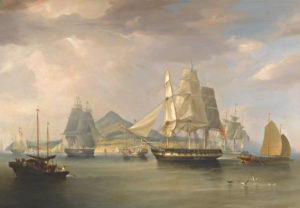
Edmund Burke, among others, warned that those who don’t know history are doomed to repeat it. So a bit of history is in order in these times when many people say that big bucks can be made producing and selling recreational drugs.
It’s true that great wealth was amassed in Massachusetts in the late 1700s and early 1800s by selling drugs. These fortunes came from the opium trade to China, notably those of James and Thomas Handasyd Perkins (benefactors of the Boston Athenaeum and the Perkins Institute for the Blind), who helped open the opium conduit from Izmir in Turkey to Canton, and of John Perkins Cushing, whose mansion house once stood on the present site of Macy’s in downtown Boston and who then moved to his country estate, Bellmont. (The town of Belmont took its name from that estate.)
But their fortunes do not tell the whole story. Not every player was a winner.
Drugs are commodities. They are subject not just to legal statutes but also to the laws of economics. The early China trade in tea, opium, and other commodities was long distance and high value. Bringing the right product to the right market at the right time was no simple matter.
Successful players were often data-obsessed, or blessed with inside connections, or both. In this economy it was as easy to lose as win.
Among traders on the China coast, opium came to be known as the “black tiger.” Cotton, equally volatile, was the “white tiger.” Traders could be taken down by a shift in the price or supply of either as suddenly and as horrifically as if attacked by a tiger. One could evade the laws of states, but not the laws of supply and demand.
Popular history glorifies drug trade winners. There were plenty of losers. Prominent among these was the Philadelphian Benjamin Chew Wilcocks, who was active in selling Turkish opium and helped open the American trade in the prized opium from India (long a British East India Company monopoly).
Wilcocks lived in Canton, China, for over 20 years, deeply in debt to Chinese merchants and failing to accumulate the surplus to allow him to return home. He was finally able to leave, only because the senior merchant Wu Bingjian tore up a $72,000 promissory note from Wilcocks, cancelling the huge debt that had stood in his way.
On his departure in 1827 Wilcocks left his share of the opium business in the hands of his partner, James Latimer. The two then quarreled. Their spat ended up in federal court in Philadelphia. Knowing that Wilcocks was looking for a bride back home, Latimer paid the passage of Fanny Henry, Wilcocks’s daughter by his Chinese paramour, from Macao to join her father and embarrass him. Coldhearted revenge by a drug dealer. Nothing new in that.
American drug traders broke only Chinese law, as recreational use of opium had been illegal there since 1729. The British faced both Chinese law and the British law that gave the East India Company (EIC) a monopoly on China trade. The EIC also monopolized opium production in India, but used private “country trade” vessels to carry the illegal cargo to Canton. Historian Michael Greenberg called this “the technique of growing opium in India and disowning it in China.”
Private British traders chafed against the opium prohibition in China, but they chafed more against the limitation on their “free trade” rights imposed by the British EIC China monopoly. Their lobbying in London succeeded when Parliament terminated that monopoly in 1834. New British traders rushed to Canton and destabilized the markets. Opium prices see-sawed and the black tiger roared. The price of import goods fell, and even though the price of export goods soared, many merchants had inadequate cash or credit to buy. The crisis of credit that resulted, worsened by the depression of 1837, produced insolvencies that became a primary excuse for the Opium War of 1839-1842.
Today many are excited by the prospect of making handsome returns in the marijuana business. Locally we see precious resources going into the production and sale of cannabis and related products. Perhaps demand will soar and happiness will spread across the land. We aren’t Puritans here, gripped by the “haunting fear that someone, somewhere, may be happy” (as H.L. Mencken put it).
Yet it seems possible that this enthusiasm will fizzle. In Canada, legalized marijuana did not live up to the euphoria, resulting in the bursting of their cannabis bubble, as recently described by the BBC.
In the U.S., with retail business staggering under high rents and competing with nimble low-cost online sellers, marijuana entrepreneurs seem to be almost the only businesses seeking brick and mortar locations. The opium trade of the 1700s and 1800s provides a warning of the cruel reality of supply and demand — but there is a key difference between the opium business then and the marijuana business now. Opium was highly addictive and thus created and maintained its own demand. Marijuana is not (even allowing for addictive personalities), so the growth potential of this market must be questioned.
Just like the opium traders who sneered at the law and operated on the China coast for many years despite bans and crackdowns, local suppliers of illegal pot aren’t likely to disappear. Presumably they will continue to serve their clientele and possibly they will adjust their prices to market conditions. Suffice it to say that the seller one meets at a dinner party isn’t carrying the expenses of licensing fees, taxes, or rent. History tells us that the laws of supply and demand will not be evaded.
Frederic Grant Jr. is an attorney in Boston who holds a Ph.D. in history and lives in Truro.



